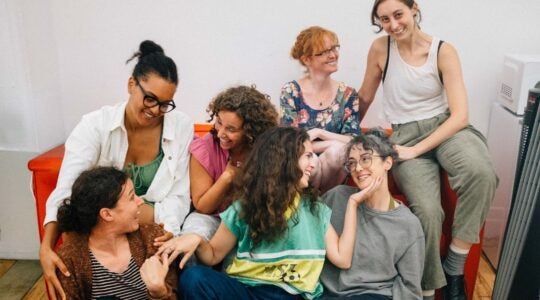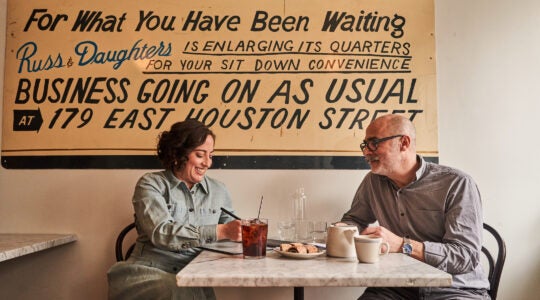Some people think of mezuzahs as a symbol of protection. For Katie, who grew up in a small town in Wisconsin, putting a mezuzah on the door of her father’s house there came to symbolize a threat.
“It’s a security thing,” said Katie, who asked that her last name not be used.
The decision not to put up the mezuzah is painful for Katie and her family, whose ancestors founded the town where she now fears anti-Semites will find out that her family is Jewish.
“After the synagogue shooting [in Pittsburgh] and after Trump’s more recent comments about disloyalty, my dad and I had a conversation, sort of just checking in, but also like, do we feel like we’re still safe here?” she said.
With anti-Semitism on the rise, most notably with two violent attacks on synagogues in the last year that left 12 people dead, Jews everywhere have been worrying, some for the first time, about their own safety and that of their institutions.
But for many Jews in rural areas and cities with smaller Jewish populations, the events of the past year have been less a surprise because of the kinds of ongoing, though less violent, anti-Semitism they’ve experienced for years.
“I don’t think that anti-Semitism is burgeoning in our society, I think it’s always been there,” said Mike Landes, a 31-year-old from Pittsfield, Mass., who now lives in Mebane, N.C., between Durham and Greensboro.
Growing up in western Massachusetts, Landes said he frequently found swastikas on the bathroom walls at his school. “This is something you notice, but there’s no commentary from anybody in the school,” he said. After he graduated from high school, he found out that a student at the school who was involved with a white supremacist group had put Landes’ name on a list of Jewish students that he kept in his notebook. Even when the school’s administrators learned about the incident, Landes said, the student was never punished.
As a kid growing up in Findlay, Ohio, in the 1970s, Linda K. Wertheimer, author of the book “Faith Ed,” woke up one morning to find her house covered in swastikas. Though she and her family thought they knew who had done it, they didn’t report it to the police. “We just felt that the community would not support us,” Wertheimer said.
In high school, when she learned about the Holocaust in her social studies class, she remembers a boy calling her an anti-Semitic slur and telling her that his grandfather was a member of the KKK.
Wertheimer said she felt the events of the last year came as less of a surprise to her than they did to others. “I think I felt like in some way that I was reacting differently than some other Jewish people who were shocked,” said Wertheimer. “It just reaffirmed what I thought, which is that anti-Semitism has been here since Jews first got here, and it’s never left.”
For Jacob Plitman, publisher of the leftist magazine Jewish Currents, growing up in High Point, N.C., left him with dozens of stories of anti-Semitic comments from people he grew up with.
He remembers when friends glued a quarter to the ground and waited around the corner to see if he’d pry it up. Several neighbors would talk to him about their financial problems, blaming them on the Rothschilds. He was frequently asked if he had horns.
“The idea that anti-Semitism ended in the United States at some point and that the U.S. is for some reason inherently a safe and pleasant place to be a Jewish person, that idea was ridiculous on its face for me,” said Plitman, who is in his late 20s.
Sarah, a 26-year-old from Jacksonville, Fla., who now lives in Boston, said her early experiences with anti-Semitism “warped my sense of things.” At her private high school, confederate flags could be found on nearly every car in the school parking lot. A fellow student once told her she would “make a beautiful lampshade,” a reference to the widely discredited myth that Nazis used the skin of Jews to make lampshades.
Sarah, who asked that her last name not be used, said her current Jewish community in Boston, and the one she was a part of in college at Brandeis University, reacted differently to anti-Semitic incidents than she did.
“At Brandeis if someone were to put a swastika on a window, the ADL and FBI would be given a call, but confederate memorabilia was very commonplace in my high school,” she said. “I think I sometimes feel more scared than I should be, and then in other spaces I think I’m the more realistic voice in the room about how much we are threatened.”
“We have to put these things in context: How often does something like Pittsburgh or Poway actually happen?” said Wertheimer. “These events are tragic and they’re extremely rare; the biggest problem for Jews in America are the microaggressions.”
Many of those microaggressions, said Landes, could be chalked up to ignorance or a lack of education. “To a certain degree, I can forgive the ignorance,” said Landes.
Other stories centered more around preaching Christianity. “Regularly people would try and convert us in the car, like if I was giving someone a ride home from basketball,” said Wertheimer. “Is that anti-Semitism or is that just ‘my religion teaches me to proselytize and so I’m going to proselytize’?”
Plitman said his stories used to shock friends who grew up in urban Jewish communities. The increase in anti-Semitism over the past several years has changed that.
“The stories,” he said, “surprise people less than they did a couple of years ago.”
More coverage: Pittsburgh: 1 Year Later
The New York Jewish Week brings you the stories behind the headlines, keeping you connected to Jewish life in New York. Help sustain the reporting you trust by donating today.




